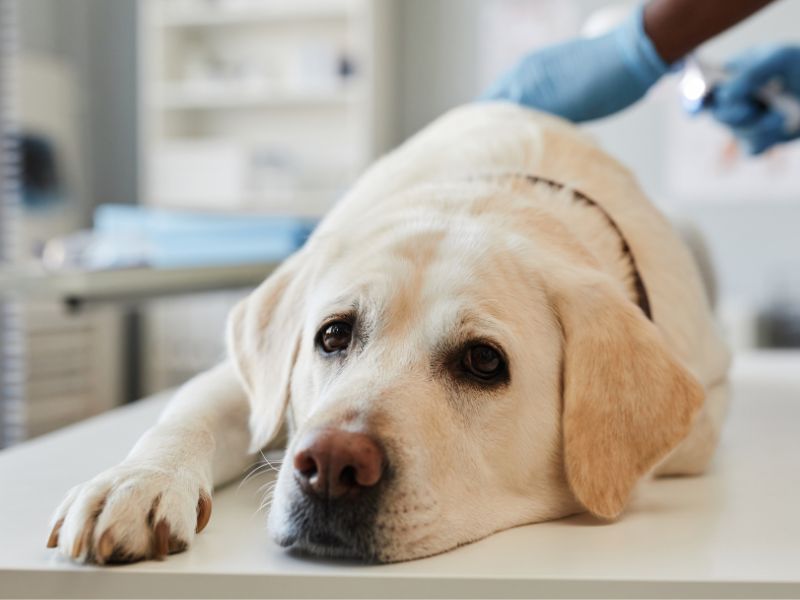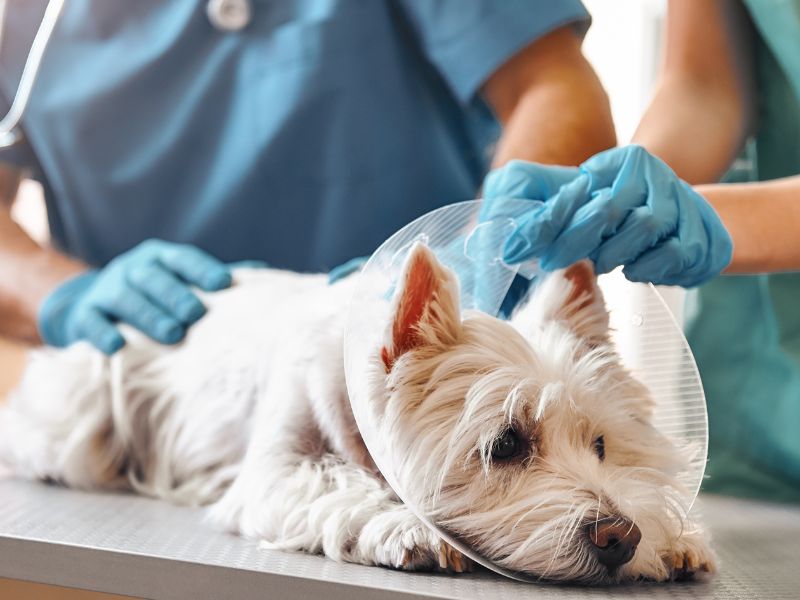Introduction
Is your furry friend sounding more like a trumpet than a playful pup? If you’ve noticed your dog wheezing, it’s natural to feel concerned. This unusual sound can be alarming for pet owners who want their companions to stay happy and healthy. Understanding the reasons behind this wheezy behavior is essential not only for peace of mind but also for determining the right course of action. Let’s explore why dogs wheeze, what it means, and how you can help your four-legged buddy breathe easier.
Why Is My Dog Wheezing
Wheezing in dogs can be unsettling and is often a sign that something is off. This sound occurs when air struggles to pass through the airways, leading to distinctive whistling noises. Understanding why your dog is wheezing can help you determine if it’s merely a temporary issue or something more serious.
Various factors contribute to this condition, from allergies and infections to structural problems like collapsing tracheas. Identifying the underlying cause will guide you toward appropriate treatment options for your beloved pet.
Causes and Treatment Options
Wheezing in dogs can have various causes. Common culprits include allergies, respiratory infections, and structural issues like a collapsing trachea. Heart disease or the presence of foreign bodies may also cause this concerning symptom. Understanding the root cause is crucial for effective treatment.
Treatment options vary depending on the diagnosis. For allergies and asthma, medications such as antihistamines or bronchodilators might be prescribed. For more serious conditions, surgery or specialized therapies could be necessary to restore your dog’s health and comfort.
Wheezing Related to Infectious Disease
Wheezing in dogs can sometimes stem from infectious diseases like kennel cough, pneumonia, or bronchitis. These conditions irritate the airways and lead to abnormal breathing sounds. If your dog is coughing frequently along with wheezing, it’s essential to consult a veterinarian.
Infectious agents such as bacteria or viruses can trigger these illnesses. Symptoms may worsen without treatment. Prompt veterinary care helps ensure your dog receives proper medications and supportive therapy for a faster recovery process.
Wheezing Related to Allergies
Wheezing in dogs can often be linked to allergies, much like in humans. Environmental factors such as pollen, dust mites, or mold can trigger a respiratory response. This reaction results in inflammation and constriction of the airways, causing that distinct wheezing sound.
Food allergies might also play a role. Certain ingredients can lead to gastrointestinal upset alongside respiratory issues. If your dog seems itchy or has skin irritations along with wheezing, allergies could be the culprit worth exploring further with your veterinarian.
Wheezing Related to Collapsing Trachea
Wheezing caused by a collapsing trachea is more common in small dog breeds like Yorkies and Chihuahuas. This condition occurs when the tracheal rings weaken, causing the airway to narrow during breathing. As your dog breathes, you may notice a harsh, honking sound alongside wheezing.
Managing this issue often involves lifestyle changes and veterinary care. Keeping your pup calm can help reduce stress on their throat. In some cases, medication or surgery might be necessary for more severe instances of collapse.
Wheezing Related to Heart Disease
Wheezing in dogs can sometimes indicate underlying heart disease. Conditions like congestive heart failure may cause fluid buildup in the lungs, leading to abnormal breathing sounds. This is particularly common in older dogs or those with pre-existing health issues.
If your dog wheezes alongside symptoms such as coughing, lethargy, or difficulty exercising, it’s crucial to consult a veterinarian. Early diagnosis and treatment are essential for managing heart conditions effectively and ensuring your furry friend remains comfortable.
If your dog is wheezing, it could be due to a foreign body lodged in their airway. Common culprits include small toys, bones, or even food that can obstruct breathing. This situation poses an immediate risk and requires urgent attention.
Dogs may exhibit distress signs like coughing or gagging alongside wheezing if something is stuck. Monitoring your pet closely for these behaviors can help you act quickly should the need arise. Always consult your veterinarian for proper diagnosis and treatment options.

Wheezing Related to Cancer
Wheezing in dogs can sometimes be linked to cancer, particularly if a tumor is pressing against the airways or lungs. This pressure may lead to restricted airflow, causing your dog to produce wheezing sounds during breathing.
Additionally, lung tumors can directly irritate the respiratory system. If you notice persistent wheezing alongside other concerning symptoms like weight loss or coughing, it’s crucial to consult your veterinarian for further evaluation and diagnosis. Early detection is key in managing any potential health issues effectively.
Does dog wheezing sound like whistling?
Yes, dog wheezing can often sound like whistling. This distinctive noise occurs when air struggles to pass through narrowed airways or obstructions in the respiratory system. Pet owners may notice it during inhalation or exhalation.
The high-pitched sound can vary in intensity depending on the underlying issue. It resembles a whistle, and it’s essential to pay attention, as it could indicate a more serious health concern that requires veterinary evaluation.
Is it normal for dogs to wheeze?
Wheezing in dogs isn’t as common as barking but can happen from time to time. It’s essential to pay attention when your furry friend makes these sounds. Occasional wheezing may not indicate a severe issue, especially if it occurs during exercise or play.
However, frequent wheezing should raise concern. It could signal underlying health problems that need veterinary attention. Always monitor your dog for other symptoms and consult with a professional if you’re unsure about their well-being.
Dog wheezing is a distinct sound that occurs when your dog has difficulty breathing. It often resembles a high-pitched whistle or raspy noise and can be alarming for pet owners. Wheezing happens due to narrowed airways, causing turbulent airflow during inhalation or exhalation.
This condition can arise from various underlying issues, including allergies, infections, or structural abnormalities in the respiratory system. Recognizing this symptom early is essential for ensuring your furry friend receives the appropriate care.
Concerning Symptoms of Dog Wheezing
Wheezing in dogs can signal more than just a minor issue. Pay close attention if your dog shows signs of difficulty breathing, persistent coughing, or excessive panting. These symptoms may indicate underlying health problems that require immediate attention.
If you notice any bluish tint to their gums or lethargy alongside wheezing, don’t hesitate to seek veterinary advice. Quick action can make a difference in your dog’s health and well-being. Always trust your instincts when it comes to their care.

How Veterinarians Diagnose Dog Wheezing
Veterinarians employ various methods to diagnose dog wheezing. Initially, they conduct a thorough physical examination, assessing the dog’s breathing patterns and overall health. They listen for abnormal lung sounds using a stethoscope, which helps identify potential respiratory issues.
Diagnostic tests, such as X-rays or blood work, may follow to pinpoint underlying causes. In some cases, veterinarians might recommend further imaging studies or bronchoscopy to get a clearer view of the airways and lungs. This comprehensive approach ensures an accurate diagnosis and effective treatment plan.
Treatment of Dog Wheezing
Treatment for dog wheezing depends on the underlying cause. If allergies are at play, your veterinarian may recommend antihistamines or corticosteroids to reduce inflammation. In cases of infections, antibiotics might be necessary to clear up any bacterial issues.
For more chronic conditions like a collapsing trachea or heart disease, ongoing management with medications can help improve your dog’s quality of life. Always consult your vet for the best course of treatment tailored to your pet’s specific needs and health condition.
Home remedies can provide some relief for a dog experiencing wheezing. Humidifiers are great for adding moisture to the air, which may help soothe your dog’s airways. Natural herbal supplements like slippery elm or licorice root can also support respiratory health.
Additionally, keeping your home free of allergens is essential. Regular cleaning helps reduce dust and pollen exposure. A calming environment with minimal stressors will further assist in managing your dog’s wheezing episodes effectively.
Recovery and Management of Dog Wheezing
Recovery from dog wheezing often involves a combination of medical treatment and lifestyle adjustments. It’s essential to follow your veterinarian’s recommendations, which may include medications or changes in diet. Creating a calm environment can also help alleviate stress on your pet’s respiratory system.
Management is key for long-term health. Regular check-ups will ensure any underlying conditions are monitored effectively. Providing clean air and avoiding smoke or allergens can significantly improve your dog’s quality of life while managing their symptoms more efficiently.

Prevention of Dog Wheezing
Preventing dog wheezing involves maintaining a clean, allergen-free environment. Vacuum your home regularly and use air purifiers to reduce dust and pollen levels. Avoid exposing your dog to smoke or strong odors that could irritate its respiratory system.
Routine veterinary check-ups are vital for early detection of potential health issues. Keeping vaccinations up-to-date can also protect against infectious diseases that may lead to wheezing. Additionally, ensuring your dog maintains a healthy weight supports overall respiratory function.
Dog Wheezing FAQs
Understanding your dog’s health can be complex. Many pet owners have questions about wheezing. It’s common to wonder, “Why is my dog wheezing?” This could indicate various issues, from allergies to more serious conditions like heart disease or cancer.
If you notice persistent wheezing, consult a veterinarian for an accurate diagnosis and treatment plan. Quick action can lead to better outcomes for your furry friend. Keep an eye on any concerning symptoms and seek help when needed. Your dog’s well-being depends on it!

